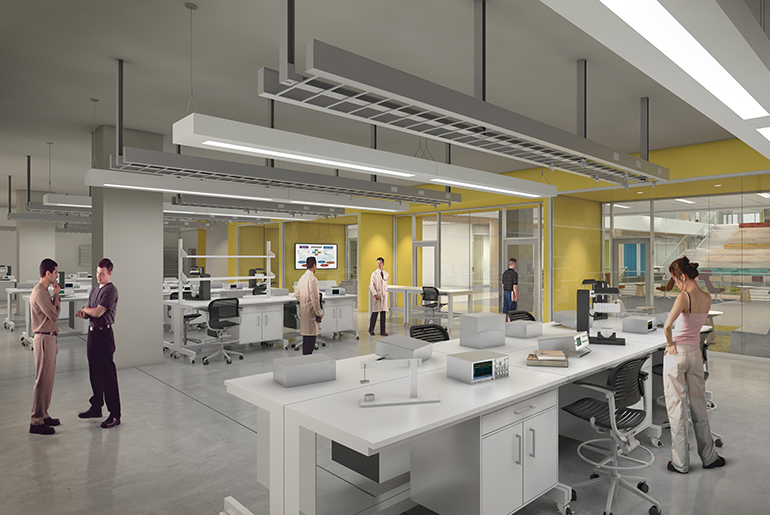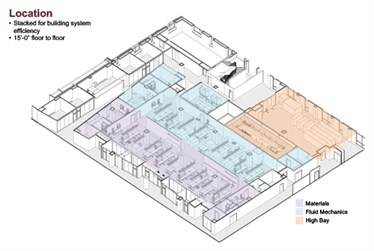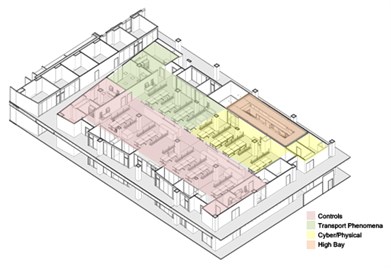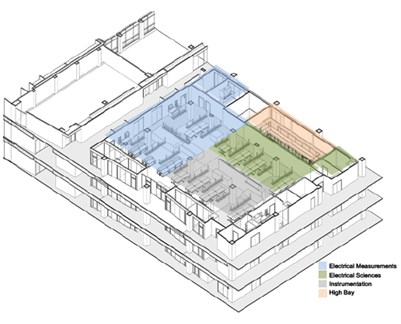
In addition to 38 active learning studios for class instruction, the Zachry Engineering Education Complex (ZACH) will offer students 30,000 square feet of multidisciplinary, hands-on learning laboratory space.
These learning laboratories will be common lab spaces, which are flexible, shared spaces that ensure the facility can be utilized efficiently; equipment duplication is minimized; and practice lab space is available more often and to more students. These multidisciplinary labs will accommodate more than 50 courses each semester.
 The labs span three floors in Zachry and are grouped into nine focus areas encompassing the shared vision of all 14 departments within the College of Engineering. The focus areas include: materials, fluids, high bay, large-scale processes, controls, cyber-physical and transport phenomena.
The labs span three floors in Zachry and are grouped into nine focus areas encompassing the shared vision of all 14 departments within the College of Engineering. The focus areas include: materials, fluids, high bay, large-scale processes, controls, cyber-physical and transport phenomena.
On the first floor located at the base of the staircase in the atrium are the Materials Laboratory, the Fluids Laboratory, and the High Bay and Large-Scale Processes Laboratory.
Directly above on the second floor are the Controls Laboratory, the Cyber-Physical Laboratory and the Transport Phenomena Laboratory.
The Electrical Measurements Laboratory, the Electrical Sciences Laboratory and the Instrumentation Laboratory are above the other labs and overlook the central atrium from the third floor.
 All labs will offer a modern laboratory infrastructure, including overhead service carriers (120-volt and 240-volt power, data, compressed air, water and specialty gases) distributed throughout the space. Movable workbenches and seating allowing easy reconfiguration of the space. Augmenting such flexible infrastructure are specialty laboratory systems including RO-water, sinks, chemical vent hoods, an RF shielded room, a 45-foot tall high bay and a crane.
All labs will offer a modern laboratory infrastructure, including overhead service carriers (120-volt and 240-volt power, data, compressed air, water and specialty gases) distributed throughout the space. Movable workbenches and seating allowing easy reconfiguration of the space. Augmenting such flexible infrastructure are specialty laboratory systems including RO-water, sinks, chemical vent hoods, an RF shielded room, a 45-foot tall high bay and a crane.
Each of the nine focus area laboratories will have a set of equipment shared and selected by various engineering departments to accommodate multiple courses in the lab. The shared environment is enabled by equipment-specific software scheduling and hardware interlocks. Engineering students from various disciplines will work side by side within these labs fostering collaboration.
Architecturally, the space is designed to be an open environment with glass walls and windows emphasizing the communal nature of the labs.
The multidisciplinary and shared nature of these labs represent a paradigm shift from the previous laboratory structure at Texas A&M and used by other universities. In addition to efficient use of space and equipment, common labs also provide greater instructor and student access to a larger variety of laboratory equipment, increasing experiential learning opportunities. The consolidation of undergraduate labs into the Zachary building also allows for the repurposing of departmental lab space for department growth and research.